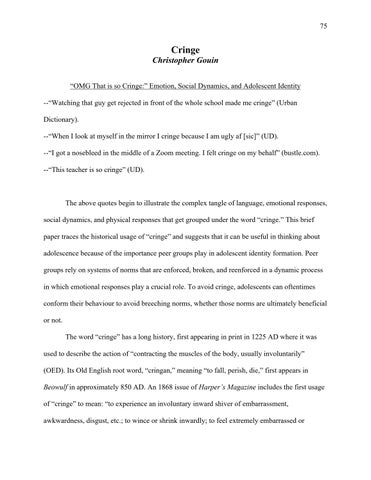75
Cringe Christopher Gouin “OMG That is so Cringe:” Emotion, Social Dynamics, and Adolescent Identity --“Watching that guy get rejected in front of the whole school made me cringe” (Urban Dictionary). --“When I look at myself in the mirror I cringe because I am ugly af [sic]” (UD). --“I got a nosebleed in the middle of a Zoom meeting. I felt cringe on my behalf” (bustle.com). --“This teacher is so cringe” (UD).
The above quotes begin to illustrate the complex tangle of language, emotional responses, social dynamics, and physical responses that get grouped under the word “cringe.” This brief paper traces the historical usage of “cringe” and suggests that it can be useful in thinking about adolescence because of the importance peer groups play in adolescent identity formation. Peer groups rely on systems of norms that are enforced, broken, and reenforced in a dynamic process in which emotional responses play a crucial role. To avoid cringe, adolescents can oftentimes conform their behaviour to avoid breeching norms, whether those norms are ultimately beneficial or not. The word “cringe” has a long history, first appearing in print in 1225 AD where it was used to describe the action of “contracting the muscles of the body, usually involuntarily” (OED). Its Old English root word, “cringan,” meaning “to fall, perish, die,” first appears in Beowulf in approximately 850 AD. An 1868 issue of Harper’s Magazine includes the first usage of “cringe” to mean: “to experience an involuntary inward shiver of embarrassment, awkwardness, disgust, etc.; to wince or shrink inwardly; to feel extremely embarrassed or
